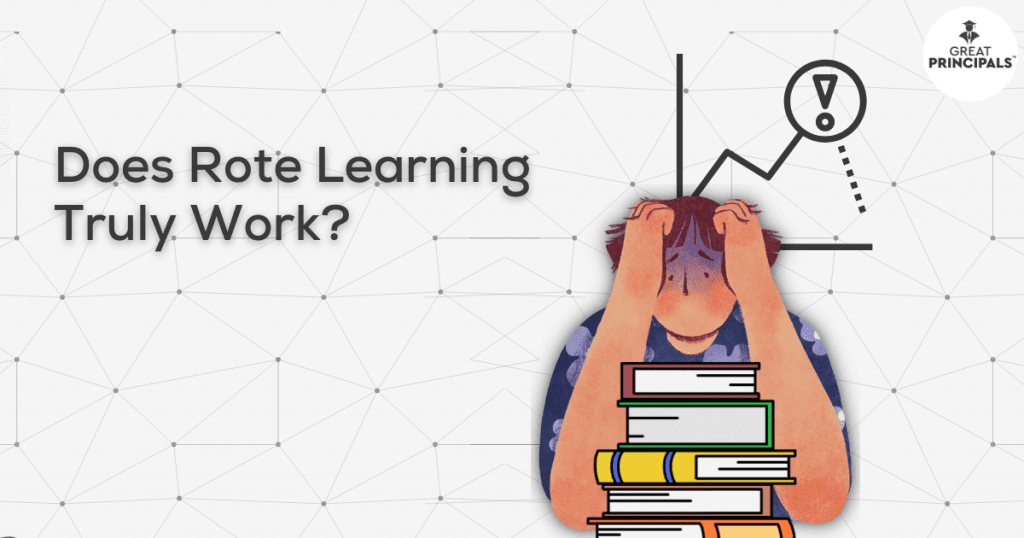“My child knows multiplications.”
“Yes, but does he know where to use it and why?” That’s exactly where the traditional education system seems to fail sometimes.
In an education system that is more focused on good grades, rote learning is one of the best methods of learning. With repetitions and incessant memorization, rote learning has been helping the students of the West as well as the East secure good marks and be considered ‘bright’.
But, does this learning method help you learn anything at all? Let’s find out!
A loop of learning and forgetting
Memorizing the syllabus is a great way to get good grades in exams. Thus, many students focus on taking in as much information as possible right before the exam. However, once the exams are done they tend to forget all the information almost immediately since there is no ‘need’ to remember it now. This creates a loop of learning and forgetting where the student memorizes everything right before the exam and forgets it after.
Applying knowledge in the real world? What?
Since the student gets trapped in the vicious cycle of learning and forgetting their lessons, they don’t understand how to ‘apply’ the knowledge. A traditional rote learning situation, where the child is more focused on getting better grades may always be too invested in memorizing everything he can. So invested that he might not get the time to understand the concept that he is memorizing and its uses of it.
Low creativity levels
So now, as the child doesn’t really remember anything he had studied before his exams and also doesn’t understand the concepts, he will start finding it difficult to formulate new ideas. Coming up with fresh ideas will start feeling like trying to write a sentence without even knowing the alphabet!
So, does Rote Learning not work at all?
Rote learning can work in certain situations. For example, in the lower grades, where the student is learning their essential basics like the numbers and alphabets, repetitions and rote learning can act as a good start.
The method of memorization also works better when it is combined with other learning methods. By combining memorization practices with more interactive methods, the perfect learning strategy can be developed for students of any age.
Alternative Learning Methods
Pre-test
The method encourages students to take a test before actually learning the topic, even if their answers might be wrong. This helps students be more confident about making mistakes and learning from them while also encouraging them to find the right answers afterward!
Self-quizzing
In this era of education where ‘tests’ breed fear among students, self-quizzing can be a great way to break away from that fear. Students should be encouraged to make quizzes and questions to test their knowledge while learning a new concept. This method can also boost the students’ sense of autonomy and confidence.
Interleaving practice
This method is especially very effective for subjects like Mathematics. Many times students find it difficult to correlate one mathematical concept with another. For example, multiplication with additions or divisions with subtractions. Interleaving practice focuses on making a set of problems and then solving that set to understand how the concepts are related. So, in this learning method, students can be given a set of Mathematical problems that include multiplication, division, addition, and subtraction rather than problems from only one of these.
After solving all the problems in the particular set, the student will understand all four of these concepts while being able to relate them to each other!
Paraphrasing and Reflecting
When it comes to arts subjects, it might be difficult to focus on the students while reading a paragraph of information. The loss of focus creates gaps in learning. So, the solution to this issue is to make sure that the child understands what he just read through. Paraphrasing the information in their own words and reflecting on the meaning of what they just jotted down can be more helpful than just reading through information mindlessly.
The rote learning method is not entirely the ‘wrong way’ of learning. Blending it with other learning methods can be very beneficial for students. However, rote learning as the only method of learning can be pretty limiting for the infinite potential that almost every student possesses. For education to truly work, students mustn’t just learn things for the sake of it but know how to use them in the real world.
At Great Principals, we hope to bring about a necessary change in the ways of Indian Education. Each new generation is far more capable than the last, and we owe it to evolution. But as humans evolve, we are required to transcend from our old ways and look at things from a different perspective, one that shapes the untapped minds of the children for the ever-growing world.
We are here to capture the journeys of marvelous School Leaders and Principals through an interactive talk show. We hope to inspire the parents who are the true changemakers in a child’s growing life. Our goal is to bring about a much-needed change in the way we educate our kids. Feel free to check out our episodes on YouTube www.youtube.com/c/GreatPrincipals
![]()
![]()


